The Legends of Longwa

The Naga Hut
The spacious bamboo hut was thatched with dried palm leaves. An impressive, ten-foot long log-drum* with a tiger’s face engraved on its front, proudly stood at the patio. A large rectangular wooden table at the center of the hall displayed pretty hand-crafted tribal chains made from bright and colorful beads. A small bonfire sat at the far corner with a bunch of people smoking opium around it. The walls of the hut were made of cane straws, fastened with a thick coat of mud and dung. Deer skulls, baskets, machete holders, hunting tools, masks, souvenirs made of wood, feathers, animal skull, horns, bones and teeth were hung on the wall. The kitchen was gloomy and coated with soot from the wood that burned in the ‘Choolah’ (hearth) day and night. A large bamboo rack stacked with corn kernels, pork meat and yam suspended from the ceiling over the ‘Choolah’. The heat from the hearth kept the items dry and kept them from decay. Millet, rice husk and corn hung in the kitchen had accumulated layers of dust and cobwebs. A dwarf circular wooden table with compact and undersized stools served as the dining area. This was our host, Noukau Wangao’s cosy little abode in one of the remotest tribal villages of Nagaland. We were in Longwa.

The hall of Noukau’s home

A typical Naga hut made with bamboo, cane and dried palm leaves. The house is adorned with deer skulls as seen on the top right section and Mithun (wild cow) skulls and horns at the bottom.
It had taken five hours on obnoxious and dusty roads to cover a mere distance of 82 kms from a small village called Sonari which is the gateway to Mon through Assam. Upon finally reaching Longwa, we* were drained and starving. Conversations began with Noukau and his family as I gobbled on my plate of hot sticky rice, boiled naga beans, roasted potato and blanched spinach leaves. While Noukau and his brother were among the very few who spoke English; the rest of Longwa spoke Nagamese and Burmese. Communication with his family was mostly animated due to the language barrier. By the time we wrapped up our lunch, it was 4 pm and the sun was already on its way down. With barely an hour of light at hand, I couldn’t afford to waste any more time.
The legendary Konyaks
The sole purpose of visiting Longwa, was to meet the tattooed men of the distinguished Konyak tribe. What sets them apart? Well, this is one of the 16 tribes of Nagaland that specialised in head-hunting. This gruesome practice was in full swing till about 70 years ago; but was later banned in the 1940s. The Konyaks were predominantly notorious warriors, participating in wars and hunting the heads of their enemies. These heads were then presented as a gift to their Chief, referred to as ‘Angh’. In return, each head hunter had his face tattooed, as a mark of pride, amidst celebrations of victory. Warriors who took part in war also had their chests tattooed.
The first head hunter I met was the 80-year old Penche. His cheeks were hollow and his wrinkled face was almost fully inked. He wore a headgear made of bear fur and feathers. Under his t-shirt and shorts, his body was reduced to skin and bones. Through his cataract-laden eyes, I could clearly sense pride and bravery. Having taken 3 heads in his lifetime, his first successful head hunt when he was just 20 years old! Penche exuded warmth when he smiled through his wrinkles while posing for a photograph.
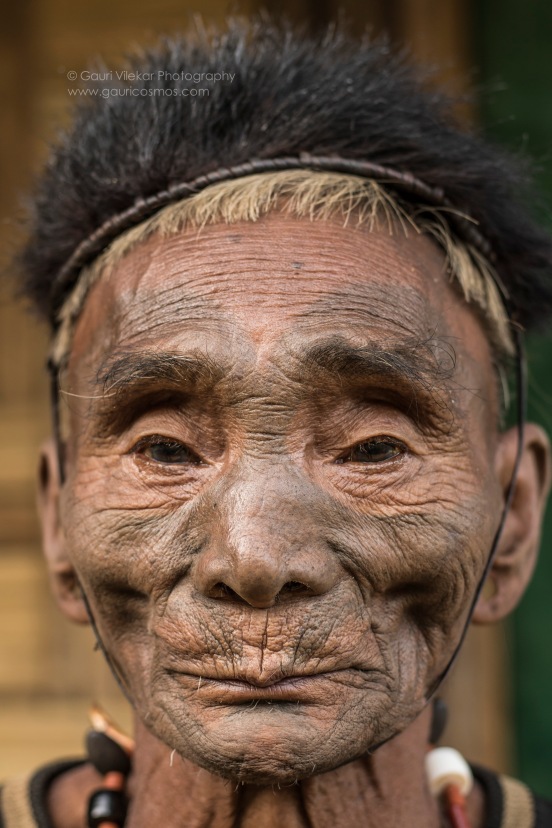
Penche, the 80-year old Konyak head hunter. The inked face denotes having hunted a head.
A few others I met after Penche, unfolded similar stories of valor. Ngowang, Wangchah and Wangnan had also taken 2 heads each. Apart from the tattoo on his face, Ngowang had a striped tattoo on his chest that extended diagonally to his belly, implying that he had also participated in war.
The Konyaks fought for land, rivers and sea and also went into Burma to extend their territories. There were 7 ‘Morungs’ (training schools) where techniques of war and head hunting were taught to the young blood. Such was the terror of the Konyaks, that the British could hardly conquer their land; nor impose any rules on the clan, except for the ban on headhunting.

Ngowang, a70-year old headhunter.

Wangchah wears a headgear of bear fur and feathers. Mithun skulls decorate his home in the background.
One of the oldest living head hunters is the 84-year old Longsha Manyam. He claims to have taken 4 heads and participated in 3 wars in his lifetime. His ear holes were huge and elongated from having worn heavy earrings made of goat and ‘Mithun’ (wild cow) horns all his life. Longsha explained that usually, headhunting was done in a group of four, one warrior held the head, other chopped it off and the remaining two carried the body and the head back to the village. Successful headhunt was followed by celebrations and of course, the tattoo ceremony. Longsha also distinctly remembered the names of the enemies whose heads he had taken, namely, Keywang, Khamwang, Phungwi and his sister.
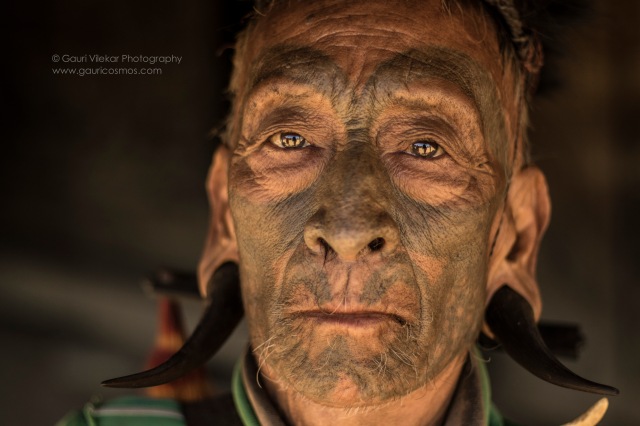
At 84, Longsha is one of the oldest living headhunter.

The faces denotes the total number of heads taken. The ornament is a symbol of pride and worn by a headhunter at all important occasions and festivals. This one was earned by Longsha.
There are only 30-odd headhunters left in Longwa, all in their declining phase of life. These legends would be gone in the next few years, only to be rediscovered in pages of a book. These men had taken me 100 years back in a time machine and their hair-raising stories had successfully given me goosebumps!
In another hut nearby, a blacksmith by the name Ongsa was engrossed in sculpting pendants. He heated metal pieces on a small fireplace and molded them into shapes; carving patterns while they were still hot. A beer can stood next to the metal pieces with tea boiling in it.
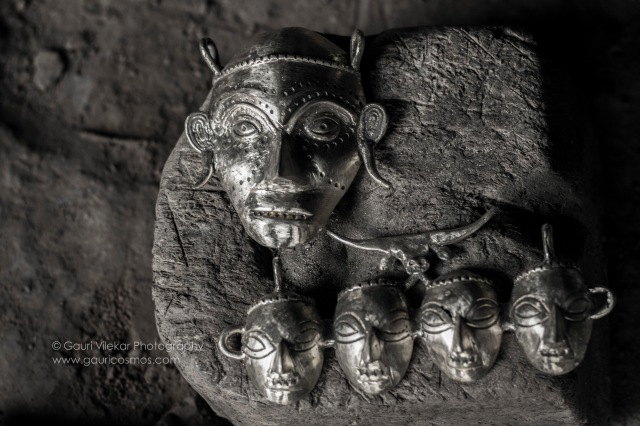
Ongsa’s creation
On the way back from Ongsa’s hut, was when the setting sun began its magical play of colors, painting Longwa into shades of gold, orange, magenta and purple in that order. The temperature dropped rapidly and winds blew like untamed beasts. By 5 pm, it grew dark. Dinner got served as early as 6.30 pm where by, the whole family along with their dog-Pity, and us, all sat together. Food menu was repetitive over the next few meals, bringing us closer to the simple and rugged lifestyle of the Nagas. Noukau’s mom, a warm and smiling lady in her late 60’s did not look anywhere close to her age. She wore a beautiful self-made neck-piece of bright orange beads that covered her neck and upper chest.
Due to limited supply of electricity, Longwa went pitch dark that night for almost an hour before the moon rose from behind the mountains. We couldn’t stop ourselves from stepping out in the open, despite the freezing cold. Every possible star twinkled over our heads and it felt as if we were under a canopy of a zillion fireflies. I had never experienced such a beautiful and clear view of the Milky Way ever before.

Sunset in Longwa is no less than a dream.

The wind shook the tripod so much that this was the best we could get!
Breakfast comprised of boiled tapioca and yam next morning. An elevated walk for a kilometer bought us to the India Myanmar border milestone. From here, we could get a bird’s eye view of entire Longwa to the left and Myanmar to the right. The view was superbly juxtaposed – shades of earthy brown on one side and green rolling hills with isolated huts on the other.

Rolling hills of Myanmar as seen from the border.

Huts scattered all over the terrain in Longwa.

Longwa as seen from the border milestone
We followed Noukau to the other end of Longwa to visit the home of the Chief, referred to as the ‘Angh‘. An Angh is the ruler of a village, basically a man of supreme authority who is greatly respected by the natives. The Angh’s hut was colossal with a log-drum and Mithun skulls at the entrance. The walls had huge metal shields and spades in varied sizes hung on it. A series of dis-coloured photographs of the Angh taken at various ceremonies also shared the wall space. But what fascinated me the most was the kitchen with the invisible India-Myanmar border cutting through it!. Sadly, the Angh had passed away the previous year, leaving behind his 60 wives and 40 odd children! Polygamy prevails among the Anghs; however, per norms, his eldest son has taken over as the new Angh of Longwa.

The Angh’s kitchen falls partly in India and partly in Myanmar!

Shields, Mithun skulls, weapons and instruments at display in the hall of the Angh’s home
While strolling in Longwa for most of the day, I encountered close to two hundred children. We happily bartered toffees for their giggles and smiles in return. Otherwise shy, they happily came forward to accept the ‘Mithai‘ being distributed. Most girls, as young as five or six, had a baby at tied securely to their backs with a towel or a shawl. It was funnily uncanny that every kid, irrespective of its age, had a runny nose :p
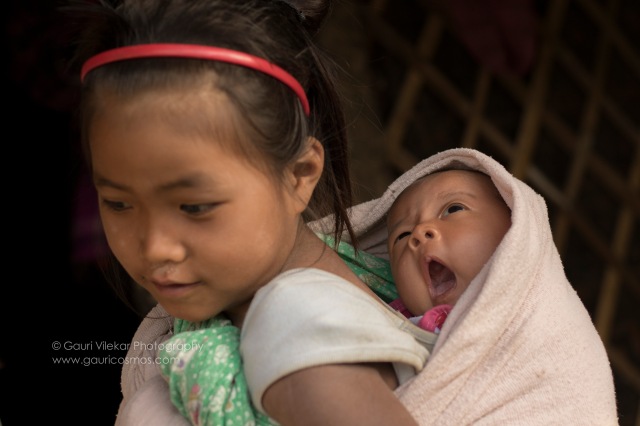

Longwa is known as the land of opium, some of which is home-grown and most of which comes in from the neighboring country. There are hardly any border restrictions. People here have dual citizenship. A few blogs had emphasized that the villagers are usually under opium influence and may prove to be dangerous, but I, per say, did not see or experience anything in particular.
I found a beautiful church with a star pinned to its top. It brings me to touch upon the religious history a bit. The Nagas strongly opposed Christianity for a very long time, primarily because it placed hard restrictions on all of their rituals and festivals. The East India company and its missionaries were able to convert most of the other tribes, but the Konyaks. Later, with time, the religion assumed a liberal approach and Christianity was eventually accepted by the Konyaks.

I loved Longwa for its ruggedness and simplicity. I also loved the fact that it is one of the very few villages where the tribes have maintained their identity and their distinct way of life despite the chaos of urbanisation around them. But I loved Longwa most for its one-of-a-kind’ Konyak headhunters, whose tattoos and hair-raising stories speak about their valorous past. And Longwa will continue to fascinate people like me who come in search of such hidden gems, long after its men would have slept with pride in their graves with their inked faces.
*A log drum is a vital instrument played by the Naga tribes by beating it with stunt wooden logs in rhythmic unison during a ceremony, festival or celebration.
**We : refers to myself and my spouse who is usually my buddy in all my travel feats.
Snippets
· Longwa is raw, rugged and minimal.
· A guide is mandatory as the native is alien to English.
· Food is extremely basic. There are no hotels or eateries. Be prepared to thrive on boiled meat, root and veggies.
· Reachability – Longwa is a 1.5 to 2 hour drive on rough roads from Mon. Shared Sumos are available from Mon with decent frequency. The best way to enter Mon is by taking a shared sumo from Sonari in Assam. Avoid evening or night travel
· Stay options: scarce. In Sonari: Hotel Green view – 78964 53604 OR Seven sister lodging (the sumo pick up point is here. In Longwa: guide makes arrangements at his homestay.
· Guide details: Contact Longsha Wangao: 8974390751 OR Belon 943625390.
· Cost(in INR) : Longsha charges 1500 per day as guide fee, 800 for a double bed room stay per night, 200 per person per meal (lunch/dinner), 120 for breakfast. Pvt sumo charges 2500 from Mon to Longwa, shared will cost around 250. Shared Sumo from Sonari to Mon is 280 per head.
· Mon, Longwa and Sonari are practically shut on Sundays and transport is not available. So plan accordingly.
· It is best to club your visit to Longwa in conjunction with the Hornbill festival that happens in Kisama (near Kohima) each year from 1-10 Dec. A state bus from Mon bus depot plies at 2 pm directly to Kohima via Sonari and takes 16 hours. Alternatively, one can go down south from Mon to Mokokchung, do a break journey and proceed to Kohima.
· Various tribes inhabit the villages around Longwa and it can be one heck of an amazing experience, however, it demands blocking a sumo all for yourself by burning a hole in your pocket. Not recommended for budget travelers.
· It gets dark by 4.30 during winter months in the north-east, leaving limited scope for exploration. Hence, its recommended to start early.
· Though websites indicate that an ILP (Inner line permit ) is required to visit Nagaland, we were told to omit it and just carry our company icards along, since leverages are given to encourage tourism during the Hornbill fest. Please check with your guide for advice.
· One may choose to buy souvenirs from Longsha’s home in Longwa, since prices in the Hornbill festival in Kohima are exorbitant.
· No harm to extend 200 to 300 INR to the headhunters for photos or interviews. No offence since their lives are not easy. And meeting these legends is priceless!
· As a custom, you need to carry a gift when you plan to visit the Angh, usually a bottle of alcohol which can be procured from Assam, since liquor is banned in Nagaland.
· Winter clothing is essential, Carry woolen gloves, socks and caps along. Nights are extremely windy.
· No pesticides are used in farming. Food is generally prepared from freshly plucked produce, though basic, its delicious!
· Adventurous people can explore opium. 🙂
· Safe for women to travel solo. Naga tribes are beautiful at heart!
- Its best to club Longwa with the hornbill festival at Kohima that happens in december every year. To read about it, click here The Hornbill Festival
Place your cursor on the image below to read the captions
The rich biodiversity of Longwa
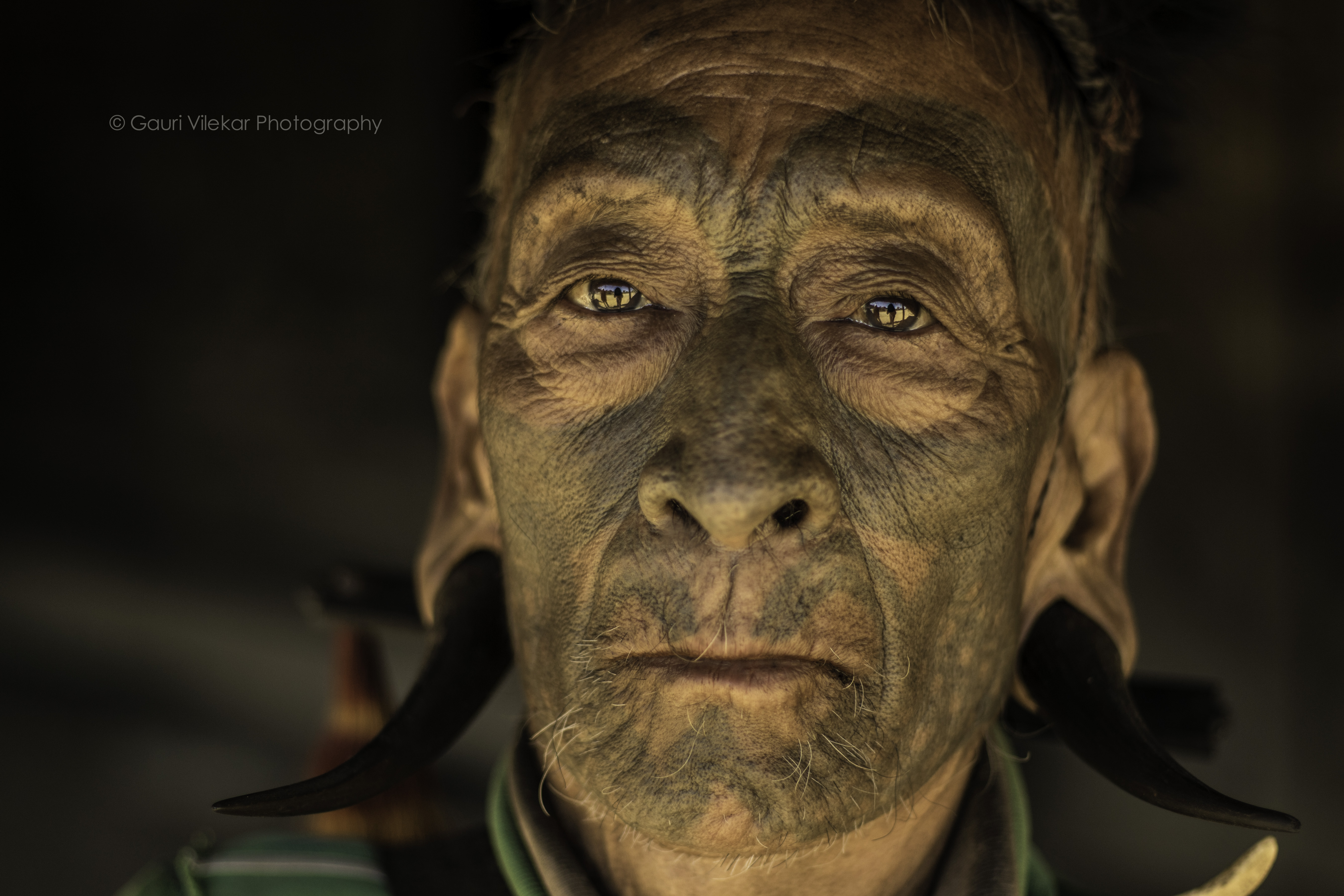














Very elaborate and very interesting Gauri👍👍👍👍
LikeLike
That was quick! Thank you for taking time out to read the entire blog and thank u for your kind words!
LikeLike
Crisp as usual. Footer tips this time added more flavor to the Blog…Superb Gauri
LikeLike
Superb writeup Guuri…very crisp & concise..your footnotes this time added more flavor to the blog
LikeLiked by 1 person
Thank you for your appreciation!
LikeLike
Pingback: The Hornbill Festival – gauricosmos